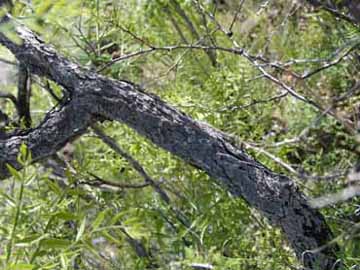Soapberry (Sapindus saponaria)
We have found few deciduous trees in locations away from our main watercourses, but in November 1998 we encountered a number of such small trees on our uplands on a north-facing slope just above the dry wash that feeds the High Tank in our Northeastern corner, shown below:

You can see one fairly substantial tree in the background, in its autumn foliage, and there are several smaller ones in the foreground, behind the leaf being displayed in close-up.
After spotting these several small trees/shrubs in 1998, we did not return to the spot until April of 2004, four full years after a Controlled Burn was conducted in this area in May of 2000. In 2004, we were surprised to see that the "Mother Tree" and several of its daughters we saw in 1998 were now dead, and burned in the fire, but in their place stands a veritable forest of dozens of saplings! -- see below:
This photograph was taken down from in the wash, looking roughly south and upslope. The blackened trunk you see in photo center is the old, largest mother tree (still displaying the bent top branch as above), but this part is now dead.
Surrounding it, however, and splaying down the slope, is a veritable array of young saplings. I counted about 20 of them, springing up all the way to the edge of the wash.
Click on the image for a more inclusive view.
This time, we not only carefully photographed but also collected some of the leaves, including inflorescence, and made our tentative identification of the trees as Arizona Walnut (Juglans major), due to the patterning of the leaves. Click on the image below for a close-up, and compare the enlarged image with that of the Walnut tree:
But Phil Jenkins, the staff botanist for the University of Arizona Herbarium, identified this plant as Soapberry, a native to our area ranging between 2,500 and 5,000 feet. According to Bowers (cited on main Trees & Shrubs page, p. 82), while it can become a tree 50 feet tall, "More often, you see it as copses of saplings along dry, sandy streambeds. The plants spread by underground rhizomes, and each copse is essentially a clone." Its leaves, while very similar to walnut leaves, "have entire rather than toothed margins", and "The inconspicuous flowers produce berries about the size and color of garbanzo beans." (More about the fruits below.)
This explained our finding not one or two trees but a number of them, a "copse" as Bowers puts it. Soapberry is not common in our lands (speaking more broadly of the San Pedro River Drainage) -- Zimmerman's 1969 distribution map shows it occurring in a much more limited distribution than (for example) Arizona Walnut: in Hot Springs Canyon around the Yellow Cliffs, and in the upper reaches of a few of the other large washes that feed into the San Pedro (e.g. Paige Wash, Soza Canyon, Robles Canyon). In his map it does not appear in the San Pedro floodplains, nor in the lower reaches of such large washes. So at present we regard it as a rarity for Saguaro Juniper.
Examining the trunk of the old Mother tree, we saw the following: below left, a view of the old trunk; below right, clear evidence that the old trunk had been burned all around its base. So the May 2000 burn -- which was very spotty along this hill slope -- caught the old mother tree and apparently killed it.
 ..
..
Here is a view of the slope looking downwash & Northward, with the new "Soapberry Copse" in the lower-right quadrant foreground and the High Tank Wash running up-photo behind it and swinging around out of sight to the left.

While the burn was very spotty along this slope, it clearly attained some intensity here, since an old formation of Yucca baccata close by (and downwind from the Soapberry trees) was completely destroyed:

Soapberries ripen by fall and often persist through thewinter. Bowers reports that "In Mexico and the Southwest, native peoples have tossed crushed soapberies in streams to stupefy fish. They also macerated soapberries in water to make lather for washing clothes and hair." Containing a high percentage of saponins (compounds known for their poisonous and medicinal properties -- they produce lather when mixed with water), these berries should not be eaten.
Return to Trees & Shrubs

